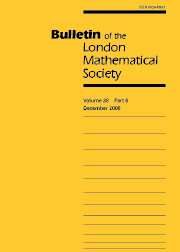Article contents
RANK PROPERTIES OF ENDOMORPHISMS OF INFINITE PARTIALLY ORDERED SETS
Published online by Cambridge University Press: 16 March 2006
Abstract
The relative rank $\mbox{\rm rank}(S:U)$ of a subsemigroup $U$ of a semigroup $S$ is the minimum size of a set $V\subseteq S$ such that $U$ together with $V$ generates the whole of $S$. As a consequence of a result of Sierpiński, it follows that for $U\leq \mathcal{T}_{X}$, the monoid of all self-maps of an infinite set $X$, $\mbox{\rm rank}(\mathcal{T}_{X}:U)$ is either 0, 1 or 2, or uncountable. In this paper, the relative ranks $\mbox{\rm rank}(\mathcal{T}_{X}:\mathcal{O}_{X})$ are considered, where $X$ is a countably infinite partially ordered set and $\mathcal{O}_{X}$ is the endomorphism monoid of $X$. We show that $\mbox{\rm rank}(\mathcal{T}_{X}:\mathcal{O}_{X})\leq 2$ if and only if either: there exists at least one element in $X$ which is greater than, or less than, an infinite number of elements of $X$; or $X$ has $|X|$ connected components. Four examples are given of posets where the minimum number of members of $\mathcal{T}_{X}$ that need to be adjoined to $\mathcal{O}_{X}$ to form a generating set is, respectively, 0, 1, 2 and uncountable.
Information
- Type
- Papers
- Information
- Copyright
- The London Mathematical Society 2006
- 12
- Cited by

